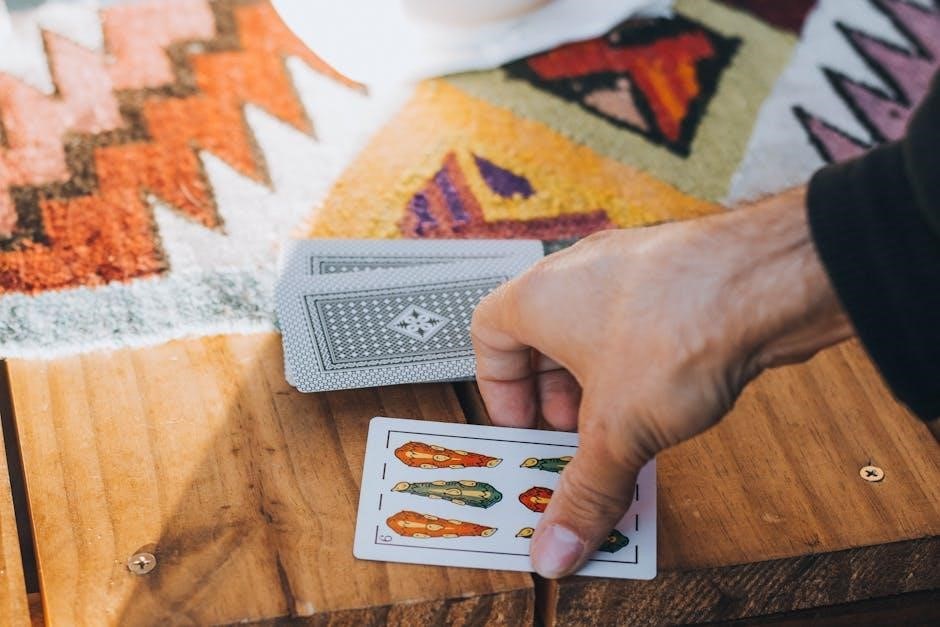Over/Under is a trivia-based card game designed by Reiner Knizia, published by Gamewright in 2008. It combines guessing and strategy, making it a fun, portable party game for 2-4 players.
1.1 Overview of the Game
Over/Under is a trivia-based card game where players estimate whether answers to unusual questions are over or under a specific value. Designed by Reiner Knizia, it combines guessing, strategy, and social interaction. The game includes 200 cards with three questions each, offering diverse challenges. Players take turns reading questions and predicting answers, with the goal of collecting the most cards by guessing correctly. Its portable design and simple rules make it ideal for parties or casual gatherings. Over/Under encourages creative thinking and laughter, making it a engaging experience for 2-4 players. The game’s quick rounds and competitive nature ensure continuous fun, appealing to both trivia enthusiasts and casual gamers alike.
1.2 Brief History and Designer
Over/Under was created by renowned game designer Reiner Knizia and published by Gamewright in 2008. Knizia, a German mathematician turned game designer, is known for his innovative and strategic games. Over/Under is part of Gamewright’s Port-A-Party series, emphasizing portability and ease of play. The game was initially released as “Die Größe macht’s!” in German, later adapted for international markets. Its success stems from Knizia’s ability to blend trivia with betting mechanics, creating a unique party experience. Over/Under has since become a staple in many game collections, praised for its accessibility and entertainment value, making it a standout title in Knizia’s extensive portfolio of award-winning games.
Components of the Game
The game includes 200 question cards, each containing three unique trivia questions. Additional materials are minimal, making it lightweight and portable for easy gameplay anywhere.
2.1 Number of Cards and Questions
The Over/Under game consists of 200 unique question cards, each featuring three distinct trivia questions. This extensive library ensures varied and engaging gameplay, catering to diverse knowledge bases. The questions cover a wide range of topics, from historical facts to scientific data, designed to challenge players’ estimation skills. With 600 questions in total, the game offers countless opportunities for fun and learning. The card design is straightforward, with clear instructions and answers printed on the back, making it easy for players to verify their guesses. This setup ensures that each round is quick and seamless, keeping the game dynamic and entertaining for all participants.
2.2 Additional Materials Needed
Beyond the base game, minimal additional materials are required to enhance gameplay. Players may benefit from pens and paper for note-taking or tracking scores. Tokens or small objects can serve as betting markers for competitive play. A flat, stable surface is essential for laying out cards and managing the game flow. While not mandatory, a timer can be used to speed up decision-making. Ensuring all players have equal access to these materials ensures fairness and smooth gameplay. These simple additions complement the core components, enriching the overall experience without complicating the setup.

Setup and Initial Rules
Begin with 2-4 players, designating one as the initial dealer. Each player receives an equal number of cards. Place an ante bet to start the game. The dealer draws the first card, and the game proceeds with players guessing “over” or “under” for each question card presented.
3.1 How to Prepare for the Game
Start by gathering 2-4 players and shuffling the deck of 200 question cards. Designate one player as the initial dealer, who will manage the card distribution. Each player should place an ante bet to begin the game. The dealer then deals the first card face-up to themselves, determining the starting point. Players should organize their betting areas, ensuring space for “Over” and “Under” bets. The dealer will then draw the first question card, reading it aloud to initiate the guessing process. Ensure all players understand the rules and betting mechanisms before proceeding. This setup ensures a smooth and organized start to the game.
3.2 Determining the Starting Player
To determine the starting player, gather all players and have them discuss who last walked under a bridge. The player who did so most recently becomes the first question master. If no one has recently walked under a bridge, choose the player who last crossed a bridge. If neither applies, the youngest player starts. The question master shuffles the deck and begins the game by reading the first question. This method adds a fun, personal touch to initiating the game, ensuring everyone starts engaged and ready to play. The role then rotates clockwise after each round, maintaining fair participation.

Rules of Play
Players guess whether answers are over or under the correct value. Correct guesses win the card, while incorrect guesses remove it. Turns pass clockwise after each round.
4.1 Guessing Mechanism: Over or Under
The core of the game revolves around the “Over or Under” guessing mechanism. Players take turns acting as the question master, drawing a card and reading one of its three trivia questions aloud. The other players then collectively estimate the correct numerical answer. The question master decides whether the given answer is either “over” or “under” the actual value. If the guess is correct, the question master wins the card and their turn ends. If incorrect, the card is discarded, and the next player becomes the question master. This dynamic mechanism ensures quick turns and engaging gameplay for all participants.
4.2 Winning Conditions for Each Round
In the Over/Under game, a player wins a round by correctly guessing whether the answer to a trivia question is “over” or “under” the actual value. If the guess is correct, the question master wins the card, adding it to their collection. The turn then ends, and the next player becomes the question master. If the guess is incorrect, the card is discarded, and the next player takes over. The game continues until a predetermined number of cards are collected. The player with the most cards at the end is declared the winner, making card accumulation the ultimate objective of the game.
4.3 Turn Progression and Card Management
During each turn, the question master draws a card and reads one of its three questions. Players then guess whether the correct answer is over or under the value provided. The question master decides if the guess is correct, awarding the card to themselves if correct or discarding it if incorrect. The turn then passes to the next player, maintaining the flow of the game. Effective card management ensures that each card is used only once, preventing repetition and keeping the game dynamic and engaging for all participants.

Variations of the Game
Over/Under offers two main variations: a party version for casual play and a casino version with betting rules, each catering to different player preferences and settings.
5.1 Party Game Version
The party version of Over/Under is designed for casual play, emphasizing fun and interaction. Players take turns as the “question master,” reading a question from the card. Others estimate whether the correct answer is higher (over) or lower (under) than a target number. If the guess is correct, the player wins the card. The game encourages laughter and debate, making it ideal for groups. Its portability and simple rules allow it to be played anywhere, making it a great choice for gatherings or events. The party version focuses on entertainment, offering a lighthearted experience for players of all ages.
5.2 Casino Version Rules
The casino version of Over/Under introduces betting elements, adding excitement and stakes. Players wager on whether the sum of three cards will be under 18 or over 23. Four to eight decks are used, with card values similar to blackjack (aces always 11). Bets are placed on “Under” or “Over,” and players win even money if correct. The game debuted at Magnolia Bluffs Casino in 2016, offering a unique blend of chance and strategy. Its simplicity makes it accessible to casino-goers, while the betting mechanism adds a thrilling layer of risk and reward, appealing to both casual and experienced players.

Strategies for Success
Analyzing question difficulty and player behavior is key. Understanding trends and managing card flow can enhance guessing accuracy, while psychological insights help in outsmarting opponents effectively.
6.1 Understanding Question Difficulty
Success in Over/Under hinges on recognizing the difficulty of questions; Easier questions yield predictable answers, making it simpler to guess if responses are over or under. Conversely, harder questions often have more variable answers, requiring careful analysis. Players should assess the knowledge level of participants and adjust their strategies accordingly. For instance, if a question pertains to common knowledge, most answers may cluster around a specific number, making it easier to predict. However, obscure or complex questions can lead to more dispersed estimates, increasing uncertainty. By identifying question difficulty, players can make more informed decisions, enhancing their chances of winning.
6.2 Psychological Aspects of Guessing
Psychology plays a crucial role in Over/Under, as players must anticipate others’ estimates. Confidence and hesitation can influence group dynamics, often leading to second-guessing. Strategic players may bluff by expressing certainty to sway others’ decisions. Additionally, the tendency to anchor on initial guesses can lead to biases, affecting accuracy. Understanding these psychological elements allows players to manipulate perceptions and gain an edge. For instance, a confident prediction might pressure others to align their guesses, even if uncertain. Conversely, cautious behavior can create doubt and spread uncertainty. Mastering these interpersonal dynamics is key to outsmarting opponents and making smarter guesses.
Over/Under is an engaging, strategic game blending trivia and psychological insight. Perfect for parties, it fosters lively interaction and laughter, making it a must-have for any game collection.
7.1 Final Thoughts on Gameplay
Over/Under offers a unique blend of trivia, strategy, and social interaction, making it a standout party game. Its simplicity and portability ensure it’s easy to learn and play anywhere. Players enjoy the challenge of estimating answers and the thrill of guessing correctly. The game’s design encourages lively discussions and laughter, fostering a fun atmosphere for gatherings. With its quick rounds and competitive nature, Over/Under appeals to a wide audience, from casual gamers to trivia enthusiasts. It’s a great addition to any game collection, providing hours of entertainment and mental stimulation. The combination of trivia and strategic guessing keeps players engaged and eager for more.
7.2 Why Over/Under is a Great Party Game
Over/Under excels as a party game due to its simplicity, portability, and ability to spark lively interactions. Its trivia-based gameplay ensures that players of all knowledge levels can participate, making it inclusive and fun for diverse groups. The guessing mechanism adds an element of unpredictability, keeping everyone engaged and laughing. The game’s quick rounds and competitive nature make it ideal for social gatherings, allowing players to jump in and out effortlessly. Its compact design ensures it can be played anywhere, from small parties to larger events. Over/Under’s unique blend of trivia and strategy creates a dynamic, entertaining experience that appeals to a wide audience, solidifying its place as a standout party game.
